Recent Progress in Photonic Crystal Devices and Their Applications: A Review
Abstract
1. Introduction
2. Photonic Crystal Structures
3. PhC-Based Polarization Maintaining WGs
4. PhC-Based Solar Cells
5. Photonic-Crystal-Based Sensors
6. PhC-Based Logic Gates
7. PhC-Based Amplifiers
8. Future Prospects
9. Conclusions
Author Contributions
Funding
Acknowledgments
Conflicts of Interest
References
- Yablonovitch, E. Inhibited spontaneous emission in solid-state physics and electronics. Phys. Rev. Lett. 1987, 58, 2059–2062. [Google Scholar] [CrossRef]
- John, S. Strong localization of photons in certain disordered dielectric superlattices. Phys. Rev. Lett. 1987, 58, 2486–2489. [Google Scholar] [CrossRef]
- Noori, M.; Soroosh, M.; Baghban, H. Self-Collimation in Photonic Crystals: Applications and Opportunities. Ann. Der Phys. 2018, 530, 1700049. [Google Scholar] [CrossRef]
- Dutta, H.S.; Goyal, A.K.; Srivastava, V.; Pal, S. Coupling light in photonic crystal waveguides: A review. Photonics Nanostructures-Fundam. Appl. 2016, 20, 41–58. [Google Scholar] [CrossRef]
- Liu, B.; Liu, Y.-F.; Jia, C.; He, X.-D. All-optical diode structure based on asymmetrical coupling by a micro-cavity and FP cavity at two sides of photonic crystal waveguide. AIP Adv. 2016, 6, 065316. [Google Scholar] [CrossRef]
- Zhang, Y.; Li, B. Photonic crystal-based bending waveguides for optical interconnections. Opt. Express 2006, 14, 5723–5732. [Google Scholar] [CrossRef] [PubMed]
- Shen, W.; Li, M.; Ye, C.; Jiang, L.; Song, Y. Direct-writing colloidal photonic crystal microfluidic chips by inkjet printing for label-free protein detection. Lab Chip 2012, 12, 3089–3095. [Google Scholar] [CrossRef]
- Zhang, Y.; Zhao, Y.; Zhou, T.; Wu, Q. Applications and developments of on-chip biochemical sensors based on optofluidic photonic crystal cavities. Lab Chip 2018, 18, 57–74. [Google Scholar] [CrossRef]
- Butt, M.A.; Kazanskiy, N.L.; Khonina, S.N. Label-free detection of ambient refractive index based on plasmonic Bragg gratings embedded resonator cavity sensor. J. Mod. Opt. 2019, 66, 1920–1925. [Google Scholar] [CrossRef]
- Butt, M.A.; Khonina, S.N.; Kazanskiy, N.L. An array of nano-dots loaded MIM square ring resonator with enhanced sensitivity at NIR wavelength range. Optik 2020, 202, 163655. [Google Scholar] [CrossRef]
- Butt, M.A.; Khonina, S.N.; Kazanskiy, N.L. Highly sensitive refractive index sensor based on hybrid plasmonic waveguide microring resonator. Waves Random Complex Media 2020, 30, 292–299. [Google Scholar] [CrossRef]
- Shen, H.; Wang, Z.; Wu, Y.; Yang, B. One-dimensional photonic crystals: Fabrication, responsiveness and emerging applications in 3D construction. RSC Adv. 2016, 6, 4505–4520. [Google Scholar] [CrossRef]
- Yu, S.-P.; Muniz, J.A.; Hung, C.-L.; Kimble, H.J. Two-dimensional photonic crystals for engineering atom–light interactions. Proc. Natl. Acad. Sci. USA 2019, 116, 12743–12751. [Google Scholar] [CrossRef] [PubMed]
- Tajiri, T.; Takahashi, S.; Ota, Y.; Watanabe, K.; Iwamoto, S.; Arakawa, Y. Three-dimensional photonic crystal simultaneously integrating a nanocavity laser and waveguides. Optica 2019, 6, 296–299. [Google Scholar] [CrossRef]
- Kumari, S.; Gupta, S. Study of Stress Effect on Optical Performance of Surface-Corrugated Hybrid Plasmonic IBG Filter. Plasmonics 2022, 17, 339–348. [Google Scholar] [CrossRef]
- Kumari, S.; Gupta, S. Simulation Study of Stress Effect on Performance and Design Methodology of Proposed Si/SiGe Integrated Bragg Grating Filter. IEEE Trans. Device Mater. Reliab. 2021, 21, 569–578. [Google Scholar] [CrossRef]
- Clementi, M.; Barone, A.; Fromherz, T.; Gerace, D.; Galli, M. Selective tuning of optical modes in a silicon comb-like photonic crystal cavity. Nanophotonics 2019, 9, 205–210. [Google Scholar] [CrossRef]
- Rostami, A.; Nazari, F.; Banaei, H.A.; Bahrami, A. A novel proposal for DWDM demultiplexer design using modified-T photonic crystal structure. Photonics Nanostructures Fundam. Appl. 2010, 8, 14–22. [Google Scholar] [CrossRef]
- Akahane, Y.; Asano, T.; Song, B.S.; Noda, S. High-Q photonic nanocavity in a two-dimensional photonic crystal. Nature 2003, 425, 944–947. [Google Scholar] [CrossRef]
- Andreani, L.C.; Gerace, D. Light-matter interaction in photonic crystal slabs. Phys. Status Solidi B 2007, 234, 3528–3539. [Google Scholar] [CrossRef]
- Mekis, A.; Chen, J.C.; Kurland, I.; Fan, S.; Villeneuve, P.R.; Joannopoulos, J.D. High transmission through sharp bends in photonic crystal waveguides. Phys. Rev. Lett. 1996, 77, 3787–3790. [Google Scholar] [CrossRef]
- Krauss, T.F. Slow light in photonic crystal waveguides. J. Phys. D Appl. Phys. 2007, 40, 2666–2670. [Google Scholar] [CrossRef]
- Chun, Z.; Feng, Q.; Jun, W.; Jian, Z. A novel polarizer made from two-dimensional photonic bandgap materials. Chin. Phys. Lett. 2001, 18, 1082–1084. [Google Scholar] [CrossRef]
- Zhao, D.; Shi, B.; Jiang, Z.; Fan, Y.; Wang, X. Silicon-based optical waveguide polarizer using photonic band gap. Appl. Phys. Lett. 2002, 81, 409–411. [Google Scholar] [CrossRef]
- Sinha, R.K.; Kalra, Y. Design of optical waveguide polarizer using photonic band gap. Opt. Express 2006, 14, 10790–10794. [Google Scholar] [CrossRef] [PubMed]
- Sinha, R.K.; Kalra, Y. Design of a photonic band gap polarizer. Opt. Eng. 2006, 45, 110503. [Google Scholar] [CrossRef][Green Version]
- Cui, Y.; Wu, Q.; Schonbrun, E.; Tinker, M.; Lee, J.-B.; Park, W. Silicon-based 2-D slab photonic crystal TM polarizer at telecommunication wavelength. IEEE Photon. Technol. Lett. 2008, 20, 641–643. [Google Scholar] [CrossRef]
- Kim, D.W.; Lee, M.H.; Kim, Y.; Kim, K.H. Ultracompact transverse magnetic mode-pass filter based on one-dimensional photonic crystals with subwavelength structures. Opt. Express 2016, 24, 21560–21565. [Google Scholar] [CrossRef] [PubMed]
- Pandey, G.N.; Kumar, N.; Singh, P.; Thapa, K.B. Analysis of Photonic Band Structure Tunability for TE and TM Modes in a Silicon and Polymer Based Ternary Photonic Crystal for Visible Range Devices. Silicon 2022, 14, 11659–11666. [Google Scholar] [CrossRef]
- Wang, B.; Blaize, S.; Salas-Montiel, R. Nanoscale plasmonic TM-pass polarizer integrated on silicon photonics. Nanoscale 2019, 11, 20685–20692. [Google Scholar] [CrossRef]
- Butt, M.A.; Khonina, S.N.; Kazanskiy, N.L. A highly sensitive design of subwavelength grating double-slot waveguide microring resonator. Laser Phys. Lett. 2020, 17, 076201. [Google Scholar] [CrossRef]
- Jervakani, A.T.; Darki, B.S. An ultracompact optical polarizer based on the one-dimensional photonic crystals containing anisotropic layers. Opt. Commun. 2023, 526, 128884. [Google Scholar] [CrossRef]
- Alam, M.; Aitchsion, J.S.; Mojahedi, M. Compact hybrid TM-pass polarizer for silicon-on-insulator platform. Appl. Opt. 2011, 50, 2294–2298. [Google Scholar] [CrossRef] [PubMed]
- Kurt, H.; Yilmaz, D.; Akosman, A.E.; Ozbay, E. Asymmetric light propagation in chirped photonic crystal waveguides. Opt. Express 2012, 20, 20635–20646. [Google Scholar] [CrossRef]
- Alam, M.Z.; Aitchison, J.S.; Mojahedi, M. Compact and silicon-on-insulatorcompatible hybrid plasmonic TE-pass polarizer. Opt. Lett. 2012, 37, 55–57. [Google Scholar] [CrossRef]
- Zhang, J.; Cassan, E.; Zhang, X. Wideband and Compact TE-pass/TM-stop polarizer based on a hybrid plasmonic bragg grating for silicon photonics. J. Light. Technol. 2014, 32, 1383–1386. [Google Scholar] [CrossRef]
- Choi, K.-H.; Huh, J.; Cui, Y.; Trivedi, K.; Hu, W.; Ju, B.-K.; Lee, J.-B. One-step combined-nanolithography and photolithograp for a 2D photonic crystal TM polarizer. Micromachines 2014, 5, 228–238. [Google Scholar] [CrossRef]
- Guan, X.; Chen, P.; Chen, S.; Xu, P.; Shi, Y.; Dai, D. Low-loss ultracompact transversemagnetic-pass polarizer with a silicon subwavelength grating waveguide. Opt. Lett. 2014, 39, 4514–4517. [Google Scholar] [CrossRef]
- Prakash, C.; Sen, M.; Mondal, H.; Goswami, K. Design and optimization of a TE-pass polarization filter based on a slotted photonic crystal waveguide. J. Opt. Soc. Am. B 2018, 35, 1791–1798. [Google Scholar] [CrossRef]
- Butt, M.A. Numerical investigation of a small footprint plasmonic Bragg grating structure with a high extinction ratio. Photonics Lett. Pol. 2020, 12, 82–84. [Google Scholar] [CrossRef]
- Kang, M.; Zhang, Z.; Wu, T.; Zhang, X.; Xu, Q.; Krasnok, A.; Han, J. Coherent full polarization control based on bound states in the continuum. Nat. Commun. 2022, 13, 4536. [Google Scholar] [CrossRef] [PubMed]
- He, X.-T.; Liu, J.-W.; Shi, F.-L.; Shen, K.; Chen, W.-J.; Chen, X.-D.; Dong, J.-W. Dual-polarization two-dimensional valley photonic crystals. Sci. China Phys. Mech. Astron. 2022, 65, 284212. [Google Scholar] [CrossRef]
- Chen, N.; Zhang, X.; Lu, X.; Zhang, Z.; Mu, Z.; Chang, M. Numerical investigation of a short polarization beam splitter based on dual-core photonic crystal fiber with As2S3 layer. Micromachines 2020, 11, 706. [Google Scholar] [CrossRef] [PubMed]
- Wen, K.; Wang, R.; Wang, J.; Li, J. Polarization beam splitter based on photonic crystal fibers. Front. Optoelectron. China 2009, 2, 76–80. [Google Scholar] [CrossRef]
- Park, I.; Lee, H.-S.; Kim, H.-J.; Moon, K.-M.; Lee, S.-G.; Beom-Hoan, O.; Park, S.-G.; Lee, E.-H. Photonic crystal power-splitter based on directional coupling. Opt. Express 2004, 12, 3599–3604. [Google Scholar] [CrossRef]
- Butt, M.; Khonina, S.; Kazanskiy, N. Compact design of a polarization beam splitter based on silicon-on-insulator platform. Laser Phys. 2018, 28, 116202. [Google Scholar] [CrossRef]
- Butt, M.; Khonina, S.; Kazanskiy, N. Optical elements based on silicon photonics. Comput. Opt. 2019, 43, 1079–1083. [Google Scholar] [CrossRef]
- Butt, M.A.; Kozlova, E.S. Multiport optical power splitter design based on coupled mode theory. J. Phys. Conf. Ser. 2019, 1368, 022006. [Google Scholar] [CrossRef]
- Butt, M.A.; Khonina, S.N.; Kazanskiy, N.L. Ultra-short lossless plasmonic power splitter design based on metal-insulator-metal waveguide. Laser Phys. 2019, 30, 016201. [Google Scholar] [CrossRef]
- Lu, Z.; Tang, Y.; Shen, Y.; Liu, X.; Zi, L. Polarization beam splitting in two dimensional photonic crystals based on negative refraction. Phys. Lett. A 2005, 346, 243–247. [Google Scholar] [CrossRef]
- Hou, J.; Wang, L.; Yang, C.; Wang, B.; Chen, S. Compact high extinction ratio asymmetric polarization beam splitter of periodic rods waveguide. Appl. Opt. 2015, 54, 10277–10282. [Google Scholar] [CrossRef] [PubMed]
- Solli, D.R.; McCormick, C.F.; Chiao, R.Y.; Hickmann, J.M. Photonic crystal polarizers and polarizing beam splitters. J. Appl. Phys. 2003, 93, 125. [Google Scholar] [CrossRef]
- Butt, M.A.; Kazanskiy, N.L. Two-dimensional photonic crystal heterostructure for light steering and TM-polarization maintaining applications. Laser Phys. 2021, 31, 036201. [Google Scholar] [CrossRef]
- Butt, M.A.; Khonina, S.N.; Kazanskiy, N.L. 2D-Photonic crystal heterostructures for the realization of compact photonic devices. Photonics Nanostructures Fundam. Appl. 2021, 44, 100903. [Google Scholar] [CrossRef]
- Dan, L.; Citrin, D.S.; Hu, S. Compact high-performance polarization beam splitter based on a silicon photonic crystal heterojunction. Opt. Mater. 2020, 109, 110256. [Google Scholar]
- Rafiee, E.; Emami, F.; Negahdari, R. Design of a novel nano plasmonic-dielectric photonic crystal power splitter suitable for photonic integrated circuits. Optik 2018, 172, 234–240. [Google Scholar] [CrossRef]
- Razmi, H.; Soroosh, M.; Kavian, Y.S. A new proposal for ultra-compact polarization independent power splitter based on photonic crystal structures. J. Opt. Commun. 2017, 39, 375–379. [Google Scholar] [CrossRef]
- Ren, C.; Wang, L.; Kang, F. Adjustable unidirectional beam splitters in two dimensional photonic crystals. Opt. Quantum Electron. 2020, 52, 475. [Google Scholar] [CrossRef]
- Kazanskiy, N.L.; Butt, M.A.; Khonina, S.N. 2D-Heterostructure Photonic Crystal Formation for On-Chip Polarization Division Multiplexing. Photonics 2021, 8, 313. [Google Scholar] [CrossRef]
- Liu, W.; Ma, H.; Walsh, A. Advance in photonic crystal solar cells. Renew. Sustain. Energy Rev. 2019, 116, 109436. [Google Scholar] [CrossRef]
- Butt, M.A.; Kazansky, N.L. Narrowband perfect metasurface absorber based on impedance matching. Photonics Lett. Pol. 2020, 12, 88–90. [Google Scholar] [CrossRef]
- Nawi, N.; Majlis, B.Y.; Mahdi, M.A.; De La Rue, R.M.; Lonĉar, M.; Md Zain, A.R. Enhancement and reproducibility of high quality factor, one-dimensional photonic crystal/photonic wire (1D PhC/PhW) microcavities. J. Eur. Opt. Soc. Publ. 2018, 14, 6. [Google Scholar] [CrossRef]
- Cen, C.; Chen, Z.; Xu, D.; Jiang, L.; Chen, X.; Yi, Z.; Wu, P.; Li, G.; Yi, Y. High Quality Factor, High Sensitivity Metamaterial Graphene—Perfect Absorber Based on Critical Coupling Theory and Impedance Matching. Nanomaterials 2020, 10, 95. [Google Scholar] [CrossRef] [PubMed]
- Mavrokefalos, A.; Han, S.E.; Yerci, S.; Branham, M.S.; Chen, G. Efficient Light Trapping in Inverted Nanopyramid Thin Crystalline Silicon Membranes for Solar Cell Applications. Nano Lett. 2012, 12, 2792–2796. [Google Scholar] [CrossRef] [PubMed]
- Yu, W.; Shen, L.; Shen, P.; Long, Y.; Sun, H.; Chen, W.; Ruan, S. Semitransparent Polymer Solar Cells with 5% Power Conversion Efficiency Using Photonic Crystal Reflector. ACS Appl. Mater. Interfaces 2014, 6, 599–605. [Google Scholar] [CrossRef] [PubMed]
- Zhang, W.; Anaya, M.; Lozano, G.; Calvo, M.E.; Johnston, M.B.; Míguez, H.; Snaith, H.J. Highly Efficient Perovskite Solar Cells with Tunable Structural Color. Nano Lett. 2015, 15, 1698–1702. [Google Scholar] [CrossRef]
- Ramos, F.J.; Oliva-Ramírez, M.; Nazeeruddin, M.K.; Graetzel, M.; González-Elipe, A.R.; Ahmad, S. Light management: Porous 1-dimensional nanocolumnar structures as effective photonic crystals for perovskite solar cells. J. Mater. Chem. A 2016, 4, 4962–4970. [Google Scholar] [CrossRef]
- Zhao, W.; Li, S.; Yao, H.; Zhang, S.; Zhang, Y.; Yang, B.; Hou, J. Molecular Optimization Enables over 13% Efficiency in Organic Solar Cells. J. Am. Chem. Soc. 2017, 139, 7148–7151. [Google Scholar] [CrossRef]
- Shi, H.; Xia, R.; Sun, C.; Xiao, J.; Wu, Z.; Huang, F.; Yip, H.-L.; Cao, Y. Synergic Interface and Optical Engineering for High-Performance Semitransparent Polymer Solar Cells. Adv. Energy Mater. 2017, 7, 1701121. [Google Scholar] [CrossRef]
- Gupta, N.D.; Janyani, V. Lambertian and photonic light trapping analysis with thickness for GaAs solar cells based on 2D periodic pattern. IET Optoelectron. 2017, 11, 217–224. [Google Scholar] [CrossRef]
- Zheng, G.; Xu, L.; Pei, S.; Su, W. Theoretical analysis of performance improvement of thin film solar cells with two-dimensional photonic crystals and distributed Bragg reflector textured structures. Opt. Commun. 2013, 309, 318–322. [Google Scholar] [CrossRef]
- Bhattacharya, S.; John, S. Designing High-Efficiency Thin Silicon Solar Cells Using Parabolic-Pore Photonic Crystals. Phys. Rev. Appl. 2018, 9, 044009. [Google Scholar] [CrossRef]
- Morsy, M.A.; Saleh, K. Efficiency Enhancement of GaAs Nano Solar Cell Based on 2D Photonic Crystal Trapping Layer and 2D Index Modulation Layer. IEEE Access 2022, 10, 44147–44158. [Google Scholar] [CrossRef]
- Zheng, X.; Zhang, L. Photonic nanostructures for solar energy conversion. Energy Environ. Sci. 2016, 9, 2511–2532. [Google Scholar] [CrossRef]
- Dotan, H.; Kfir, O.; Sharlin, E.; Blank, O.; Gross, M.; Dumchin, I.; Ankonina, G.; Rothschild, A. Resonant light trapping in ultrathin films for water splitting. Nat. Mater. 2013, 12, 158–164. [Google Scholar] [CrossRef]
- Cheng, K.; Li, Q.; Meng, J.; Han, X.; Wu, Y.; Wang, S.; Qian, L.; Du, Z. Interface engineering for efficient charge collection in Cu2O/ZnO heterojunction solar cells with ordered ZnO cavity-like nanopatterns. Sol. Energy Mater. Sol. Cells 2013, 116, 120–125. [Google Scholar] [CrossRef]
- Yan, T.; Yuan, R.; Li, W.; You, J. Origin of superior photocatalytic activity in rutile TiO2 hierarchical microspheres: The dominate role of “microcavity” structure. Appl. Catal. A Gen. 2014, 478, 204–210. [Google Scholar] [CrossRef]
- An, C.J.; Cho, C.; Choi, J.K.; Park, J.-M.; Jin, M.L.; Lee, J.-Y.; Jung, H.-T. Highly Efficient Top-Illuminated Flexible Polymer Solar Cells with a Nanopatterned 3D Microresonant Cavity. Small 2014, 10, 1278–1283. [Google Scholar] [CrossRef]
- Zheng, W.; Luo, X.; Zhang, Y.; Ye, C.; Qin, A.; Cao, Y.; Hou, L. Efficient Low-Cost All-Flexible Microcavity Semitransparent Polymer Solar Cells Enabled by Polymer Flexible One-Dimensional Photonic Crystals. ACS Appl. Mater. Interfaces 2020, 12, 23190–23198. [Google Scholar] [CrossRef]
- Zhong, J.; Liang, W.; Long, Y. Simultaneously improving efficiency and transparency of semitransparent organic solar cells by constructing semitransparent microcavity. Optik 2018, 171, 706–714. [Google Scholar] [CrossRef]
- Wang, C.; Geng, A.; Guo, Y.; Jiang, S.; Qu, X.; Li, L. A novel preparation of three-dimensionally ordered macroporous M/Ti (M = Zr or Ta) mixed oxide nanoparticles with enhanced photocatalytic activity. J. Colloid Interface Sci. 2006, 301, 236–247. [Google Scholar] [CrossRef] [PubMed]
- Zhou, M.; Wu, H.B.; Bao, J.; Liang, L.; Lou, X.W.D.; Xie, Y. Ordered Macroporous BiVO 4 Architectures with Controllable Dual Porosity for Efficient Solar Water Splitting. Angew. Chem. Int. Ed. 2013, 52, 8579–8583. [Google Scholar] [CrossRef]
- Zhou, M.; Bao, J.; Xu, Y.; Zhang, J.; Xie, J.; Guan, M.; Wang, C.; Wen, L.; Lei, Y.; Xie, Y. Photoelectrodes Based upon Mo:BiVO 4 Inverse Opals for Photoelectrochemical Water Splitting. ACS Nano 2014, 8, 7088–7098. [Google Scholar] [CrossRef] [PubMed]
- Zhang, L.; Baumanis, C.; Robben, L.; Kandiel, T.; Bahnemann, D. Bi2WO6 Inverse Opals: Facile Fabrication and Efficient Visible-Light-Driven Photocatalytic and Photoelectrochemical Water-Splitting Activity. Small 2011, 7, 2714–2720. [Google Scholar] [CrossRef] [PubMed]
- Chen, X.; Ye, J.; Ouyang, S.; Kako, T.; Li, Z.; Zou, Z. Enhanced Incident Photon-to-Electron Conversion Efficiency of Tungsten Trioxide Photoanodes Based on 3D-Photonic Crystal Design. ACS Nano 2011, 5, 4310–4318. [Google Scholar] [CrossRef] [PubMed]
- Choi, D.H.; Nam, S.K.; Jung, K.; Moon, J.H. 2D photonic crystal nanodisk array as electron transport layer for highly efficient perovskite solar cells. Nano Energy 2019, 56, 365–372. [Google Scholar] [CrossRef]
- Bhattacharya, S.; John, S. Beyond 30% Conversion Efficiency in Silicon Solar Cells: A Numerical Demonstration. Sci. Rep. 2019, 9, 12482–12515. [Google Scholar] [CrossRef]
- Cheng, C.; Karuturi, S.K.; Liu, L.; Liu, J.; Li, H.; Su, L.T.; Tok, A.I.Y.; Fan, H.J. Quantum-Dot-Sensitized TiO2 Inverse Opals for Photoelectrochemical Hydrogen Generation. Small 2012, 8, 37–42. [Google Scholar] [CrossRef]
- Lu, Y.; Yu, H.; Chen, S.; Quan, X.; Zhao, H. Integrating Plasmonic Nanoparticles with TiO2 Photonic Crystal for Enhancement of Visible-Light-Driven Photocatalysis. Environ. Sci. Technol. 2012, 46, 1724–1730. [Google Scholar] [CrossRef]
- Dinh, C.-T.; Yen, H.; Kleitz, F.; Do, T.-O. Three-Dimensional Ordered Assembly of Thin-Shell Au/TiO2 Hollow Nanospheres for Enhanced Visible-Light-Driven Photocatalysis. Angew. Chem. Int. Ed. 2014, 53, 6618–6623. [Google Scholar] [CrossRef]
- Zhang, L.; Lin, C.; Valev, V.K.; Reisner, E.; Steiner, U.; Baumberg, J.J. Plasmonic Enhancement in BiVO4 Photonic Crystals for Efficient Water Splitting. Small 2014, 10, 3970–3978. [Google Scholar] [CrossRef] [PubMed]
- Li, H.; Hu, X.; Hong, W.; Cai, F.; Tang, Q.; Zhao, B.; Zhang, D.; Cheng, P. Photonic crystal coupled plasmonic nanoparticle array for resonant enhancement of light harvesting and power conversion. Phys. Chem. Chem. Phys. 2012, 14, 14334. [Google Scholar] [CrossRef] [PubMed]
- Gangwar, R.K.; Qin, J.; Wang, X. Porous Silicon–Based Microring Resonator for Temperature and Cancer Cell Detection. Front. Phys. 2022, 10. [Google Scholar] [CrossRef]
- Pathak, A.K.; Viphavakit, C. A Review on All-optical Fiber-based VOC sensors: Heading Towards the Development of Promising Technology. Sens. Actuators A Phys. 2022, 338, 113455. [Google Scholar] [CrossRef]
- Kumari, S.; Gupta, S. Cladding stress induced performance variation of silicon MMI coupler. Photonics Nanostructures Fundam. Appl. 2019, 33, 55–65. [Google Scholar] [CrossRef]
- Kumari, S.; Gupta, S. Performance Estimation of Hybrid Plasmonic Waveguide in Presence of Stress. Plasmonics 2021, 16, 359–370. [Google Scholar] [CrossRef]
- Rahman, B.M.A.; Viphavakit, C.; Chitaree, R.; Ghosh, S.; Pathak, A.K.; Verma, S.; Sakda, N. Optical Fiber, Nanomaterial, and THz-Metasurface-Mediated Nano-Biosensors: A Review. Biosensors 2022, 12, 42. [Google Scholar] [CrossRef]
- Malinin, A.V.; Zanishevskaja, A.A.; Tuchin, V.V.; Skibina, Y.S.; Silokhin, I.Y. Photonic Crystal Fibers for Food Quality Analysis; Popp, J., Drexler, W., Tuchin, V.V., Matthews, D.L., Eds.; 2012; p. 842746. Available online: https://www.spiedigitallibrary.org/conference-proceedings-of-spie/8427/842746/Photonic-crystal-fibers-for-food-quality-analysis/10.1117/12.924096.short (accessed on 4 October 2023).
- Falconi, M.C.; Palma, G.; Starecki, F.; Nazabal, V.; Troles, J.; Adam, J.L.; Taccheo, S.; Ferrari, M.; Prudenzano, F. Novel pumping schemes of Mid-IR photonic crystal fiber lasers for aerospace applications. In Proceedings of the 2016 18th International Conference on Transparent Optical Networks (ICTON), Trento, Italy, 10–14 July 2016; pp. 1–5. [Google Scholar]
- Mashev, L.; Popov, E. Diffraction efficiency anomalies of multicoated dielectric gratings. Opt. Commun. 1984, 51, 131–136. [Google Scholar] [CrossRef]
- Zhou, Y.; Zhang, M.; Guo, Z.; Miao, L.; Han, S.-T.; Wang, Z.; Zhang, X.; Zhang, H.; Peng, Z. Recent advances in black phosphorus-based photonics, electronics, sensors and energy devices. Mater. Horiz. 2017, 4, 997–1019. [Google Scholar] [CrossRef]
- Jágerská, J.; Zhang, H.; Diao, Z.; Le Thomas, N.; Houdré, R. Refractive index sensing with an air-slot photonic crystal nanocavity. Opt. Lett. 2010, 35, 2523. [Google Scholar] [CrossRef]
- Zhao, H.-J. High sensitivity refractive index gas sensing enhanced by surface plasmon resonance with nano-cavity antenna array. Chin. Phys. B 2012, 21, 087104. [Google Scholar] [CrossRef]
- Wang, L.; Sang, T.; Li, J.; Zhou, J.; Wang, B.; Wang, Y. High-sensitive transmission type of gas sensor based on guided-mode resonance in coupled gratings. J. Mod. Opt. 2018, 65, 1601–1608. [Google Scholar] [CrossRef]
- Zu, P.; Chan, C.C.; Jin, Y.; Gong, T.; Zhang, Y.; Chen, L.H.; Dong, X. A Temperature-Insensitive Twist Sensor by Using Low-Birefringence Photonic-Crystal-Fiber-Based Sagnac Interferometer. IEEE Photonics Technol. Lett. 2011, 23, 920–922. [Google Scholar] [CrossRef]
- Lu, H.; Sadani, B.; Ulliac, G.; Guyot, C.; Courjal, N.; Collet, M.; Baida, F.I.; Bernal, M.-P. Integrated temperature sensor based on an enhanced pyroelectric photonic crystal. Opt. Express 2013, 21, 16311–16318. [Google Scholar] [CrossRef] [PubMed]
- Shafiee, H.; Lidstone, E.A.; Jahangir, M.; Inci, F.; Hanhauser, E.; Henrich, T.J.; Kuritzkes, D.R.; Cunningham, B.T.; Demirci, U. Nanostructured Optical Photonic Crystal Biosensor for HIV Viral Load Measurement. Sci. Rep. 2015, 4, 4116. [Google Scholar] [CrossRef]
- Bouzidi, A.; Bria, D.; Akjouj, A.; Pennec, Y.; Djafari-Rouhani, B. A tiny gas-sensor system based on 1D photonic crystal. J. Phys. D Appl. Phys. 2015, 48, 495102. [Google Scholar] [CrossRef]
- Hameed, M.F.O.; Azab, M.Y.; Heikal, A.M.; El-Hefnawy, S.M.; Obayya, S.S.A. Highly Sensitive Plasmonic Photonic Crystal Temperature Sensor Filled With Liquid Crystal. IEEE Photonics Technol. Lett. 2016, 28, 59–62. [Google Scholar] [CrossRef]
- Liu, Y.; Zhou, W.; Sun, Y. Optical Refractive Index Sensing Based on High-Q Bound States in the Continuum in Free-Space Coupled Photonic Crystal Slabs. Sensors 2017, 17, 1861. [Google Scholar] [CrossRef]
- Maurya, J.; François, A.; Prajapati, Y. Two-Dimensional Layered Nanomaterial-Based One-Dimensional Photonic Crystal Refractive Index Sensor. Sensors 2018, 18, 857. [Google Scholar] [CrossRef]
- Snapp, P.; Kang, P.; Leem, J.; Nam, S. Colloidal Photonic Crystal Strain Sensor Integrated with Deformable Graphene Phototransducer. Adv. Funct. Mater. 2019, 29, 1902216. [Google Scholar] [CrossRef]
- Resende, S.; Frasco, M.F.; Sales, M.G.F. A biomimetic photonic crystal sensor for label-free detection of urinary venous thromboembolism biomarker. Sens. Actuators B Chem. 2020, 312, 127947. [Google Scholar] [CrossRef]
- Kawasaki, D.; Yamada, H.; Sueyoshi, K.; Hisamoto, H.; Endo, T. Imprinted Photonic Crystal-Film-Based Smartphone-Compatible Label-Free Optical Sensor for SARS-CoV-2 Testing. Biosensors 2022, 12, 200. [Google Scholar] [CrossRef] [PubMed]
- Pu, S.; Bai, X.; Wang, L. Temperature dependence of photonic crystals based on thermoresponsive magnetic fluids. J. Magn. Magn. Mater. 2011, 323, 2866–2871. [Google Scholar] [CrossRef]
- Su, D.; Pu, S.; Mao, L.; Wang, Z.; Qian, K. A Photonic Crystal Magnetic Field Sensor Using a Shoulder-Coupled Resonant Cavity Infiltrated with Magnetic Fluid. Sensors 2016, 16, 2157. [Google Scholar] [CrossRef]
- Aazi, M.; Kudinova, M.; Kinet, D.; Auguste, J.-L.; Delépine-Lesoille, S.; Mégret, P.; Humbert, G. Impact of H2 gas on disruptive birefringence optical fibers with embedded Palladium particles for developing robust sensors. J. Phys. Photonics 2020, 2, 014005. [Google Scholar] [CrossRef]
- Pathak, A.K.; Viphavakit, C. VOC Biomarker Monitoring for Diabetes Through Exhaled Breath Using Ag/P-TiO2 Composite Plasmonic Sensor. IEEE Sens. J. 2021, 21, 22631–22637. [Google Scholar] [CrossRef]
- Liu, H.; Zhang, Y.; Chen, C.; Bai, B.; Shao, Q.; Wang, H.; Zhang, W.; Chen, C.; Tang, S. Transverse-Stress Compensated Methane Sensor Based on Long-Period Grating in Photonic Crystal Fiber. IEEE Access 2019, 7, 175522–175530. [Google Scholar] [CrossRef]
- Kraeh, C.; Martinez-Hurtado, J.L.; Popescu, A.; Hedler, H.; Finley, J.J. Slow light enhanced gas sensing in photonic crystals. Opt. Mater. 2018, 76, 106–110. [Google Scholar] [CrossRef]
- Sardar, M.R.; Faisal, M. Methane Gas Sensor Based on Microstructured Highly Sensitive Hybrid Porous Core Photonic Crystal Fiber. J. Sens. Technol. 2019, 9, 12–26. [Google Scholar] [CrossRef]
- Chang, Y.; Hasan, D.; Dong, B.; Wei, J.; Ma, Y.; Zhou, G.; Ang, K.W.; Lee, C. Surface-Enhanced Infrared Absorption-Based CO2 Sensor using Photonic Crystal Slab. In Proceedings of the 2019 IEEE 32nd International Conference on Micro Electro Mechanical Systems (MEMS), Seoul, Republic of Korea, 27–31 January 2019; pp. 141–144. [Google Scholar]
- Liu, Y.; Wang, S.; Biswas, P.; Palit, P.; Zhou, W.; Sun, Y. Optofluidic vapor sensing with free-space coupled 2D photonic crystal slabs. Sci. Rep. 2019, 9, 4209. [Google Scholar] [CrossRef]
- Wang, X.; Lv, J.; E, S.; Han, B.; Zhang, Y. Theoretical Design and Simulation Optimization of Photonic Crystal Cavity for Tetrahydrofuran Vapor Sensing. Phys. Status Solidi 2019, 256, 1900221. [Google Scholar] [CrossRef]
- Britto, E.C.; Nizar, S.M.; Krishnan, P. A Highly Sensitive Photonic Crystal Fiber Gas Sensor for the Detection of Sulfur Dioxide. Silicon 2022, 14, 12665–12674. [Google Scholar] [CrossRef]
- Loga, K.; Nizar, S.M.; Caroline, B.E. Design of Photonic Crystal Fiber Based Gas Sensor for Sensing Nitrous Oxide (N2O) and Benzene (C6H6) at Atmospheric Level. In Proceedings of the 2022 International Conference on Smart Technologies and Systems for Next Generation Computing (ICSTSN), Villupuram, India, 25–26 March 2022; pp. 1–6. [Google Scholar]
- Ghods, M.M.; Afsahi, M. Ultra-sensitive absorption-based gas detecting using graphene-covered periodic photonic crystal slabs resonating under critical coupling condition at mid-infrared frequencies. IEEE Trans. Nanobioscience 2022, 22, 143–148. [Google Scholar] [CrossRef] [PubMed]
- Zegadi, R.; Zegadi, A.; Zebiri, C.; Mosbah, S.; Mekki, S.; Bouknia, M.L.; Bendjedi, H. Enhanced 2D Photonic Crystal Sensor for High Sensitivity Sulfuric Acid (H2SO4) and Hydrogen Peroxide (H2O2) Detection. Silicon 2022, 14, 11001–11006. [Google Scholar] [CrossRef]
- Klimov, N.N.; Mittal, S.; Berger, M.; Ahmed, Z. On-chip silicon waveguide Bragg grating photonic temperature sensor. Opt. Lett. 2015, 40, 3934–3936. [Google Scholar] [CrossRef]
- Gangwar, R.K.; Bhardwaj, V.; Singh, V.K. Magnetic field sensor based on selectively magnetic fluid infiltrated dual-core photonic crystal fiber. Opt. Eng. 2016, 55, 026111. [Google Scholar] [CrossRef]
- Kumar Vyas, A.; Kumar Gangwar, R.; Kumar, S. Elliptical air hole PCF-based low-cost sensor for refractive index and temperature detection: Design and analysis. Opt. Fiber Technol. 2022, 73, 103060. [Google Scholar] [CrossRef]
- Yang, F.; Wang, Z.K.; Wang, D.N. A highly sensitive optical fiber strain sensor based on cascaded multimode fiber and photonic crystal fiber. Opt. Fiber Technol. 2019, 47, 102–106. [Google Scholar] [CrossRef]
- Ying, Y.; Hu, N.; Si, G.; Xu, K.; Liu, N.; Zhao, J.-Z. Magnetic field and temperature sensor based on D-shaped photonic crystal fiber. Optik 2019, 176, 309–314. [Google Scholar] [CrossRef]
- Li, Q.; Liu, S.; Wang, J.; Mbola, N.M.; Meng, Z.; Wang, X.; Xue, M. A biocompatible, self-adhesive, and stretchable photonic crystal sensor for underwater motion detection. J. Mater. Chem. C 2022, 10, 9025–9034. [Google Scholar] [CrossRef]
- Dinodiya, S.; Bhargava, A. A Comparative Analysis of Pressure Sensing Parameters for Two Dimensional Photonic Crystal Sensors Based on Si and GaAs. Silicon 2022, 14, 4611–4618. [Google Scholar] [CrossRef]
- Biswas, U.; Rakshit, J.K.; Suthar, B.; Kumar, D.; Nayak, C. Modeling and analysis of all-optical pressure sensor using photonic crystal based micro ring resonator. Int. J. Numer. Model. Electron. Netw. Devices Fields 2022, 35, e2962. [Google Scholar] [CrossRef]
- Gupta, P.K.; Tripathi, S.; Paltani, P.P. Optical Add/Drop Filter and Pressure Sensor Design Using Two-Dimensional Photonic Crystal. In Proceedings of the 2022 Workshop on Recent Advances in Photonics (WRAP), Mumbai, India, 4–6 March 2022; pp. 1–2. [Google Scholar]
- Meng, X.; Zhao, Y.; Li, J.; Guo, Y.; Li, S.; Guo, H.; Du, H.; Li, Z.; Li, M.; Feng, Y.; et al. High-performance plasmonic sensor based on photonic crystal fiber for refractive index and temperature sensing. Infrared Phys. Technol. 2022, 122, 104036. [Google Scholar] [CrossRef]
- Gangwar, R.K.; Singh, V.K. Highly Sensitive Surface Plasmon Resonance Based D-Shaped Photonic Crystal Fiber Refractive Index Sensor. Plasmonics 2017, 12, 1367–1372. [Google Scholar] [CrossRef]
- Pathak, A.K.; Rahman, B.M.A.; Viphavakit, C. Nanowire Embedded Micro-Drilled Dual-Channel Approach to Develop Highly Sensitive Biosensor. IEEE Photonics Technol. Lett. 2022, 34, 707–710. [Google Scholar] [CrossRef]
- Mustafa, Q.M.S.; Kadhim, R.A.; Kalankesh, H.V.; Pourziad, A. Dual-channel plasmonic refractive index sensor based on H-shaped optical fibres for multi-analyte detection. J. Opt. 2022, 52, 1171–1179. [Google Scholar] [CrossRef]
- Minkovich, V.P.; Sotsky, A.B. Tapered photonic crystal fibers coated with ultra-thin films for highly sensitive bio-chemical sensing. J. Eur. Opt. Soc. Publ. 2019, 15, 7. [Google Scholar] [CrossRef]
- Pathak, A.K.; Ghosh, S.; Gangwar, R.K.; Rahman, B.M.A.; Singh, V.K. Metal Nanowire Assisted Hollow Core Fiber Sensor for an Efficient Detection of Small Refractive Index Change of Measurand Liquid. Plasmonics 2019, 14, 1823–1830. [Google Scholar] [CrossRef]
- Mahmud, S.S.; Islam, M.T.; Atiqullah, S.M. Poisonous Chemical Sensing Using Highly Sensitive Terahertz Photonic Crystal Fiber Sensor. In Proceedings of the 2019 4th International Conference on Electrical Information and Communication Technology (EICT), Khulna, Bangladesh, 20–22 December 2019; pp. 1–5. [Google Scholar]
- Mohammed, N.A.; Hamed, M.M.; Khalaf, A.A.M.; Alsayyari, A.; El-Rabaie, S. High-sensitivity ultra-quality factor and remarkable compact blood components biomedical sensor based on nanocavity coupled photonic crystal. Results Phys. 2019, 14, 102478. [Google Scholar] [CrossRef]
- De, M.; Pathak, A.K.; Singh, V.K. Single channel photonic crystal fiber based high sensitive petrol adulteration detection sensor. Optik 2019, 183, 539–546. [Google Scholar] [CrossRef]
- Ramanujam, N.R.; El-Khozondar, H.J.; Dhasarathan, V.; Taya, S.A.; Aly, A.H. Design of one dimensional defect based photonic crystal by composited superconducting material for bio sensing applications. Phys. B Condens. Matter 2019, 572, 42–55. [Google Scholar] [CrossRef]
- Panda, A.; Pukhrambam, P.D.; Dadure, P.; Pakray, P. Application of Machine Learning for Accurate Detection of Hemoglobin Concentrations Employing Defected 1D Photonic Crystal. Silicon 2022, 14, 12203–12212. [Google Scholar] [CrossRef]
- Chen, Y.-T.; Liao, Y.-Y.; Chen, C.-C.; Hsiao, H.-H.; Huang, J.-J. Surface plasmons coupled two-dimensional photonic crystal biosensors for Epstein-Barr virus protein detection. Sens. Actuators B Chem. 2019, 291, 81–88. [Google Scholar] [CrossRef]
- Mostafa, T.S.; Mohammed, N.A.; El-Rabaie, E.-S.M. Ultra-High bit rate all-optical AND/OR logic gates based on photonic crystal with multi-wavelength simultaneous operation. J. Mod. Opt. 2019, 66, 1005–1016. [Google Scholar] [CrossRef]
- Rao, D.G.S.; Swarnakar, S.; Kumar, S. Performance analysis of all-optical NAND, NOR, and XNOR logic gates using photonic crystal waveguide for optical computing applications. Opt. Eng. 2020, 59, 057101. [Google Scholar] [CrossRef]
- Rao, D.G.S.; Palacharla, V.; Swarnakar, S.; Kumar, S. Design of all-optical D flip-flop using photonic crystal waveguides for optical computing and networking. Appl. Opt. 2020, 59, 7139–7143. [Google Scholar] [CrossRef]
- Rao, D.G.S.; Swarnakar, S.; Kumar, S. Design of all-optical reversible logic gates using photonic crystal waveguides for optical computing and photonic integrated circuits. Appl. Opt. 2020, 59, 11003–11012. [Google Scholar] [CrossRef]
- Krauss, T.F.; Rue, R.M.D.L.; Brand, S. Two-dimensional photonic-bandgap structures operating at near-infrared wavelengths. Nature 1996, 383, 699–702. [Google Scholar] [CrossRef]
- Swarnakar, S.; Kumar, S.; Sharma, S. Design of all-optical half-subtractor circuit device using 2-D principle of photonic crystal waveguides. J. Opt. Commun. 2019, 40, 195–203. [Google Scholar]
- Rao, D.G.S.; Swarnakar, S.; Kumar, S. Design of photonic crystal based compact all-optical 2 × 1 multiplexer for optical processing devices. Microelectron. J. 2021, 112, 105046. [Google Scholar] [CrossRef]
- Rachana, M.; Swarnakar, S.; Krishna, S.V.; Kumar, S. Design and analysis of an optical three-input AND gate using a photonic crystal fiber. Appl. Opt. 2022, 61, 77–83. [Google Scholar] [CrossRef] [PubMed]
- Rao, D.G.S.; Swarnakar, S.; Palacharla, V.; Raju, K.S.R.; Kumar, S. Design of all-optical AND, OR, and XOR logic gates using photonic crystals for switching applications. Photonic Netw. Commun. 2021, 41, 109–118. [Google Scholar] [CrossRef]
- Painter, O.; Lee, R.K.; Scherer, A.; Yariv, A.; O’Brien, J.D.; Dapkus, P.D.; Kim, I. Two-dimensional photonic bandgap defect mode laser. Science 1999, 284, 1819–1821. [Google Scholar] [CrossRef] [PubMed]
- Adibi, A.; Lee, R.; Xu, Y.; Yariv, A.; Scherer, A. Design of photonic crystal optical waveguides with single-mode propagation in the photonic bandgap. Electron. Lett. 2000, 36, 1376–1378. [Google Scholar] [CrossRef]
- Mizuta, E.; Watanabe, H.; Baba, T. All semiconductor low-photonic crystal waveguide for semiconductor optical amplifier. Jpn. J. Appl. Phys. 2006, 45, 6116–6120. [Google Scholar] [CrossRef]
- Nozaki, K.; Tanabe, T.; Shinya, A.; Matsuo, S.; Sato, T.; Taniyama, H.; Notomi, M. Sub-femtojoule all-optical switching using a photoniccrystal nanocavity. Nat. Photon. 2010, 4, 477–483. [Google Scholar]
- MÃ, J.; Berg, T.W. The Dynamics of Semiconductor Optical Amplifiers: Modeling and Applications. Opt. Photonics News 2003, 14, 42–48. [Google Scholar]
- Krauss, T.F.; Wilson, R.; Baets, R.; Bogaerts, W.; Kristensen, M.; Borel, P.I.; Frandsen, L.H.; Thorhauge, M.; Tromborg, B. Lavrinenko, Photonic Integrated Circuits using Crystal Optics, PICCO. In Proceedings of the 11th European Conference on Integrated Optics, ECIO’03, Prague, Czech Republic, 2–4 April 2003; pp. 115–120. [Google Scholar]
- Shih, M.-H. Photonic Crystal Devices for Photonic Integrated Circuits; ProQuest Dissertations Publishing: Ann Arbor, MI, USA, 2006. [Google Scholar]
- Mandal, M.; De, P.; Lakshan, S.; Sarfaraj, M.N.; Hazra, S.; Dey, A.; Mukhopadhyay, S. A review of electro-optic, semiconductor optical amplifier and photonic crystal-based optical switches for application in quantum computing. J. Opt. 2023, 52, 603–611. [Google Scholar]
- Cao, T.; Ho, Y.L.D.; Heard, P.J.; Barry, L.P.; Kelly, A.E.; Cryan, M.J. Fabrication and measurement of a photonic crystal waveguide integrated with a semiconductor optical amplifier. J. Opt. Soc. Am. B 2009, 26, 768–777. [Google Scholar] [CrossRef]
- Zhang, Y.; Zheng, W.; Qi, A.; Qu, H.; Chen, L. Optical amplification based on slow light effects in the photonic crystal waveguide. Microw. Opt. Technol. Lett. 2011, 53, 2997–3001. [Google Scholar] [CrossRef]
- Chen, Y.; Mørk, J. Simulation of nonlinear gain saturation in active photonic crystal waveguides. In Proceedings of the Photonics in Switching, PS, 2012 International Conference on IEEE, Ajaccio, France, 11–14 September 2012; pp. 1–3. [Google Scholar]
- Kotb, A.; Zoiros, K.E. Performance analysis of all-optical XOR gate with photonic crystal semiconductor optical amplifier-assisted Mach-Zehnder interferometer at 160 Gb/s. Opt. Commun. 2017, 402, 511–517. [Google Scholar] [CrossRef]
- Kotb, A.; Zoiros, K.E.; Guo, C. 160 Gb/s photonic crystal semiconductor optical amplifiers-based all-optical logic NAND gate. Photon. Netw. Commun. 2018, 36, 246–255. [Google Scholar] [CrossRef]
- Kotb, A.; Zoiros, K.E.; Guo, C. Ultrafast performance of all-optical AND and OR logic operations at 160 Gb/s using using photonic crystal semiconductor optical amplifer. Opt. Laser Technol. 2019, 119, 1–10. [Google Scholar] [CrossRef]
- Nosratpour, A.; Razaghi, M.; Darvish, G. Computational study of pulse propagation in photonic crystal semiconductor optical amplifier. J. Nanophoton. 2018, 12, 036015. [Google Scholar]
- Mishra, C.S. Design and analysis of L shape photonic waveguide for realisation of power amplifier application. Opt. Mater. 2022, 127, 112298. [Google Scholar] [CrossRef]
- Capocefalo, A.; Quintiero, E.; Bianco, M.; Zizzari, A.; Gentilini, S.; Conti, C.; Arima, V.; Viola, I.; Ghofraniha, N. Random Laser Spectral Fingerprinting of Lithographed Microstructures. Adv. Mater. Technol. 2021, 6, 2001037. [Google Scholar] [CrossRef]
- Massaro, L.M.; Gentilini, S.; Portone, A.; Camposeo, A.; Pisignano, D.; Conti, C.; Ghofraniha, N. Heterogeneous Random Laser with Switching Activity Visualized by Replica Symmetry Breaking Maps. ACS Photonics 2021, 8, 376–383. [Google Scholar] [CrossRef]
- Chen, S.-W.; Lu, J.-Y.; Hung, B.-Y.; Chiesa, M.; Tung, P.-H.; Lin, J.-H.; Yang, T.C.-K. Random lasers from photonic crystal wings of butterfly and moth for speckle-free imaging. Opt. Express 2021, 29, 2065–2076. [Google Scholar] [CrossRef]
- Ford, A.D.; Morris, S.C.; Coles, H.J. Polymer whispering gallery mode lasers. Opt. Mater. 1998, 9, 12–17. [Google Scholar]
- Gao, H.; Zhao, Y.G.; Ho, S.T.; Seelig, E.W.; Wang, Q.H.; Chang, R.P.H. Random Laser Action in Semiconductor Powder. Phys. Rev. Lett. 1999, 82, 2278–2281. [Google Scholar]
- Kuehne, A.J.C.; Gather, M.C. Organic Lasers: Recent Developments on Materials, Device Geometries, and Fabrication Techniques. Chem. Rev. 2016, 116, 12823–12864. [Google Scholar] [CrossRef] [PubMed]
- Potyrailo, R.A.; Starkey, T.A.; Vukusic, P.; Ghiradell, H.; Vasudev, M.; Bunning, T.; Naik, R.R.; Tang, Z.; Larsen, M.; Deng, T.; et al. Discovery of the surface polarity gradient on iridescent Morpho butterfly scales reveals a mechanism of their selective vapor response. Proc. Natl. Acad. Sci. USA 2013, 110, 15567–15572. [Google Scholar] [CrossRef] [PubMed]
- Ruiz-Clavijo, A.; Tsurimaki, Y.; Caballero-Calero, O.; Ni, G.; Chen, G.; Boriskina, S.V.; Martín-González, M. Engineering a Full Gamut of Structural Colors in All-Dielectric Mesoporous Network Metamaterials. ACS Photonics 2018, 5, 2120–2128. [Google Scholar] [CrossRef]
- Zhang, F.; Shen, Q.; Shi, X.; Li, S.; Wang, W.; Luo, Z.; He, G.; Zhang, P.; Tao, P.; Song, C.; et al. Infrared Detection Based on Localized Modification of Morpho Butterfly Wings. Adv. Mater. 2015, 27, 1077–1082. [Google Scholar] [CrossRef]
- Waterhouse, G.I.N.; Chen, W.-T.; Chan, A.; Sun-Waterhouse, D. Achieving Color and Function with Structure: Optical and Catalytic Support Properties of ZrO2 Inverse Opal Thin Films. ACS Omega 2018, 3, 9658–9674. [Google Scholar] [CrossRef] [PubMed]
- Wang, C.-S.; Chang, T.-Y.; Lin, T.-Y.; Chen, Y.-F. Biologically inspired flexible quasi-single-mode random laser: An integration of Pieris canidia butterfly wing and semiconductors. Sci. Rep. 2015, 4, 6736. [Google Scholar] [CrossRef]
- Zhang, H.; Feng, G.; Wang, S.; Yang, C.; Yin, J.; Zhou, S. Coherent random lasing from liquid waveguide gain channels with biological scatters. Appl. Phys. Lett. 2014, 105, 253702. [Google Scholar] [CrossRef]
- Türeci, H.E.; Ge, L.; Rotter, S.; Stone, A.D. Strong Interactions in multimode random lasers. Science 2008, 320, 643–646. [Google Scholar] [CrossRef]
- Zaitsev, O.; Deych, L. Recent developments in the theory of multimode random lasers. J. Opt. 2010, 12, 024001. [Google Scholar] [CrossRef][Green Version]
- Lei, W.; Pu, S. Tunable Slow Light with Large Bandwidth and Low-dispersion in Photonic Crystal Waveguide Infiltrated with Magnetic Fluids. J. Magn. 2015, 20, 110–113. [Google Scholar] [CrossRef]
- Pu, S.; Dong, S.; Huang, J. Tunable slow light based on magnetic-fluid-infiltrated photonic crystal waveguides. J. Opt. 2014, 16, 045102. [Google Scholar] [CrossRef]
- Pu, S.; Wang, H.; Wang, N.; Zeng, X. Extremely large bandwidth and ultralow-dispersion slow light in photonic crystal waveguides with magnetically controllability. Appl. Phys. B 2013, 112, 223–229. [Google Scholar] [CrossRef]
- Pu, S.; Wang, H.; Wang, N.; Zeng, X. Tunable flat band slow light in reconfigurable photonic crystal waveguides based on magnetic fluids. Opt. Commun. 2013, 311, 16–19. [Google Scholar] [CrossRef][Green Version]
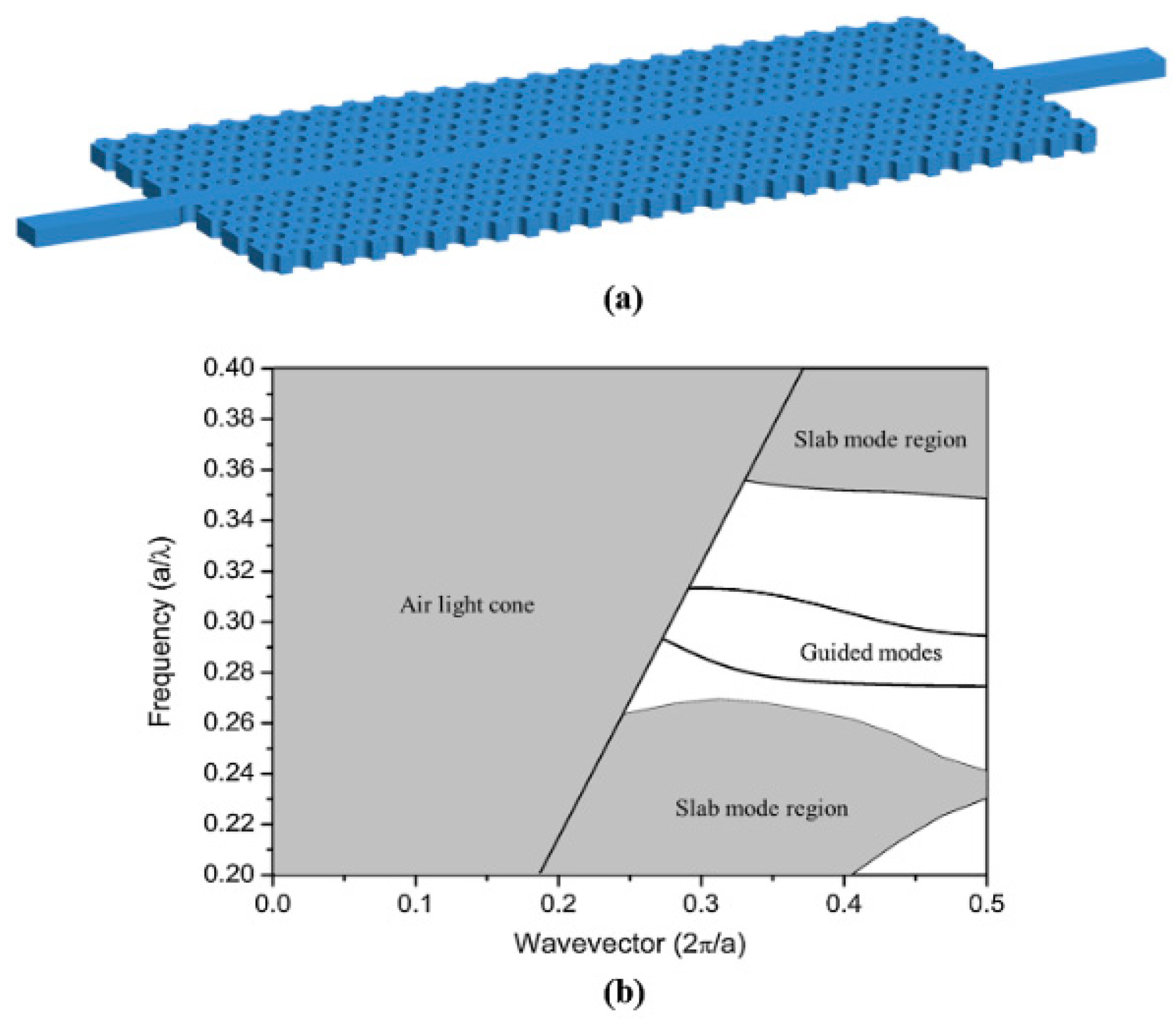
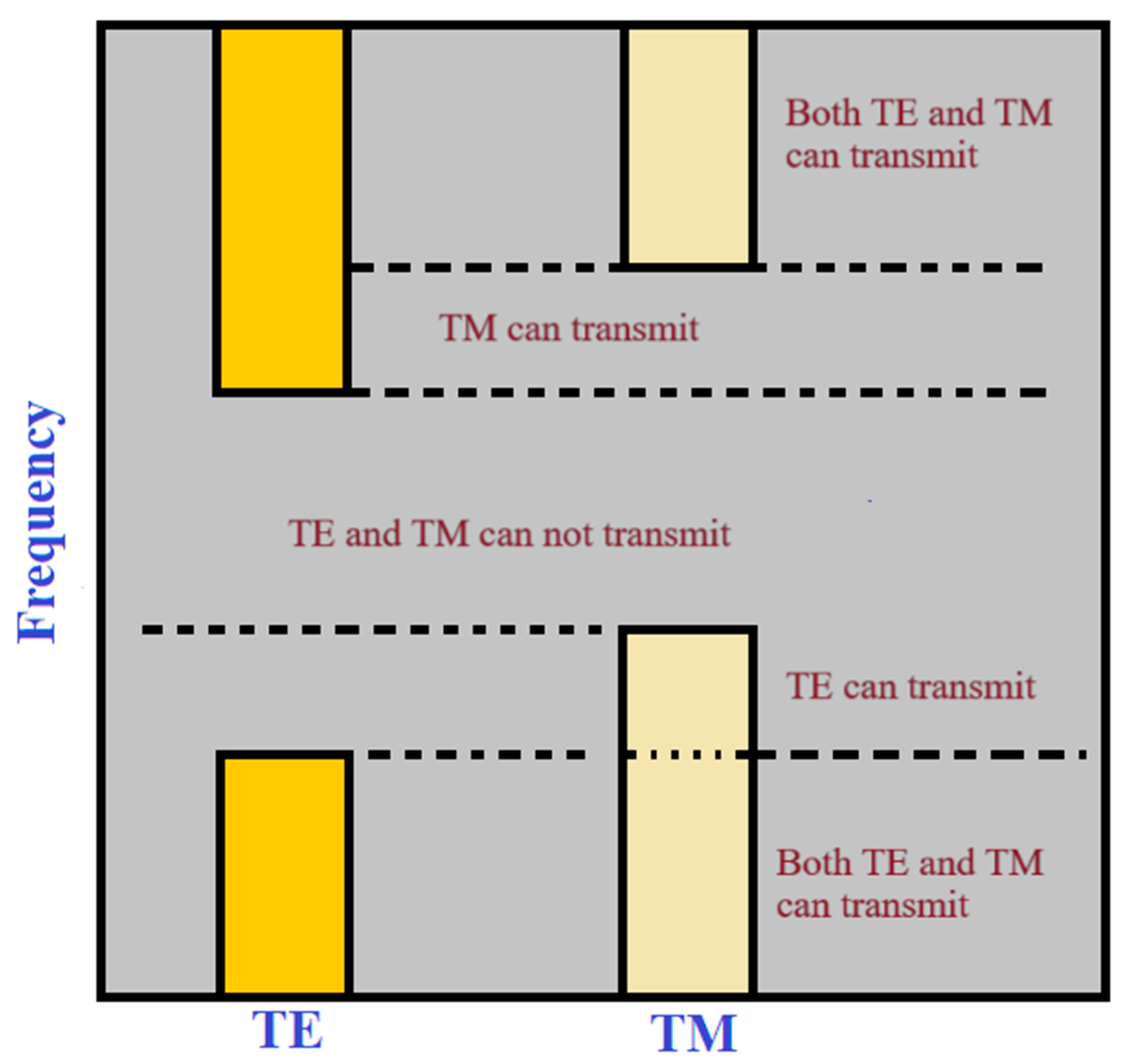



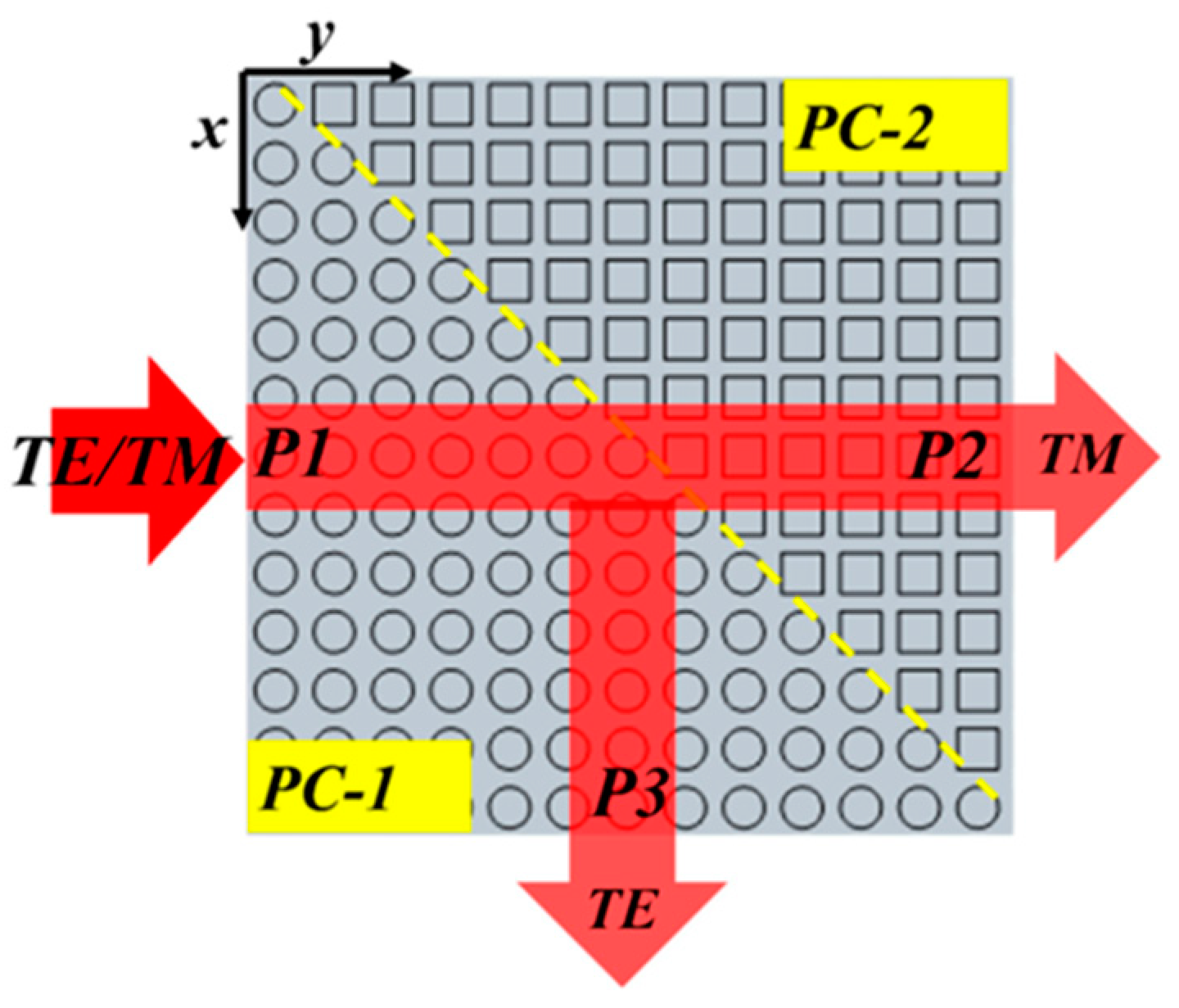


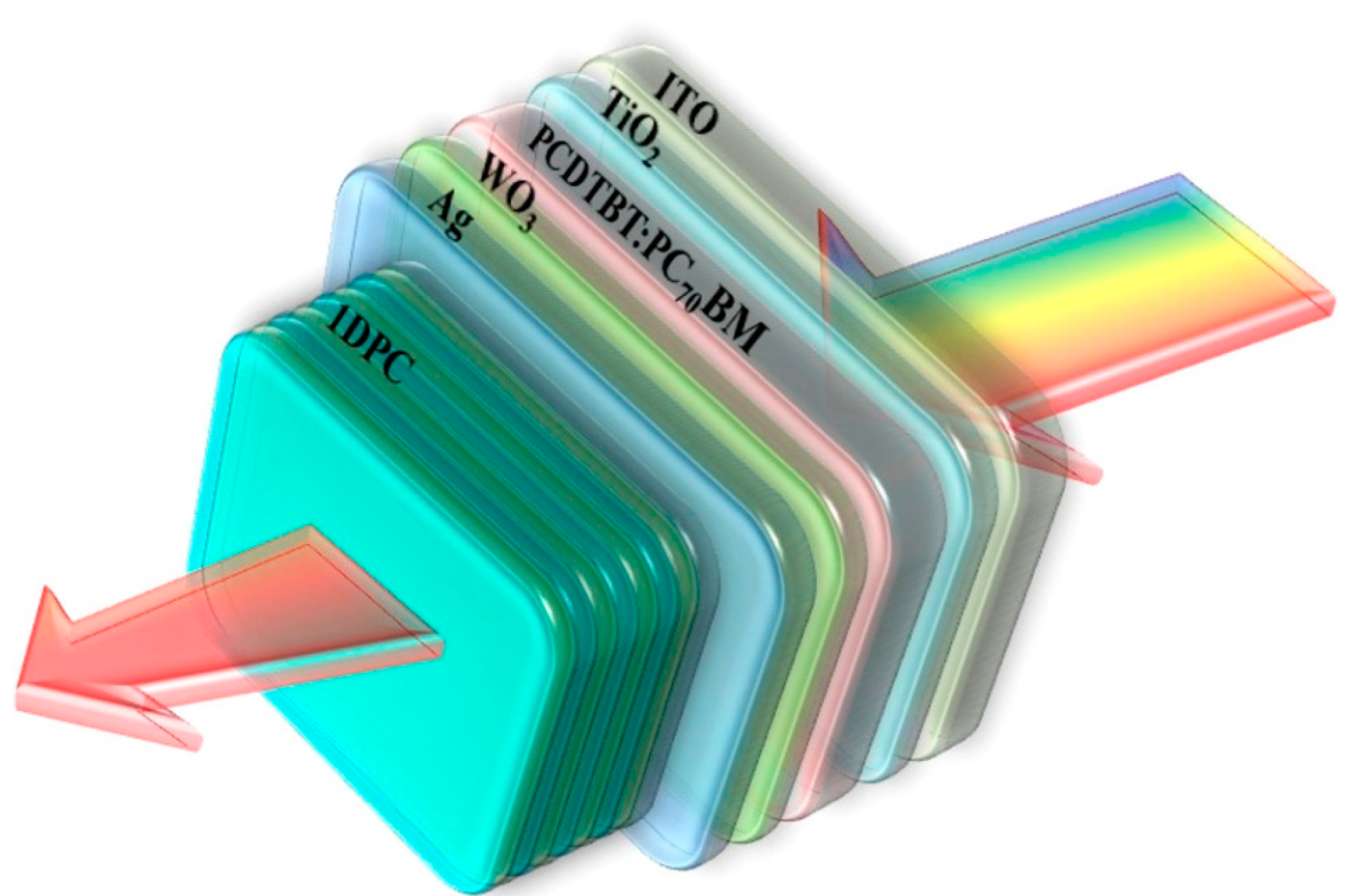
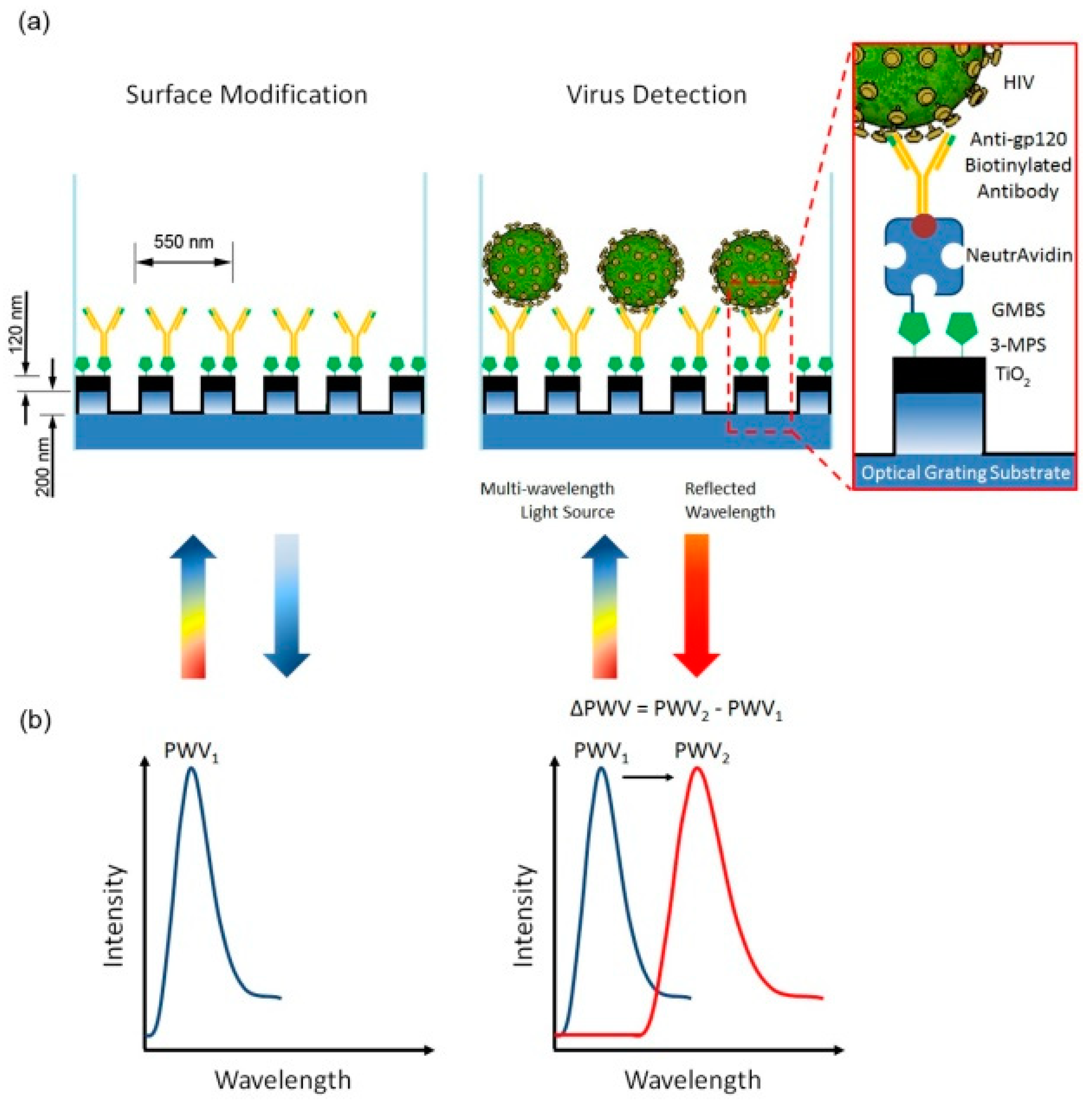
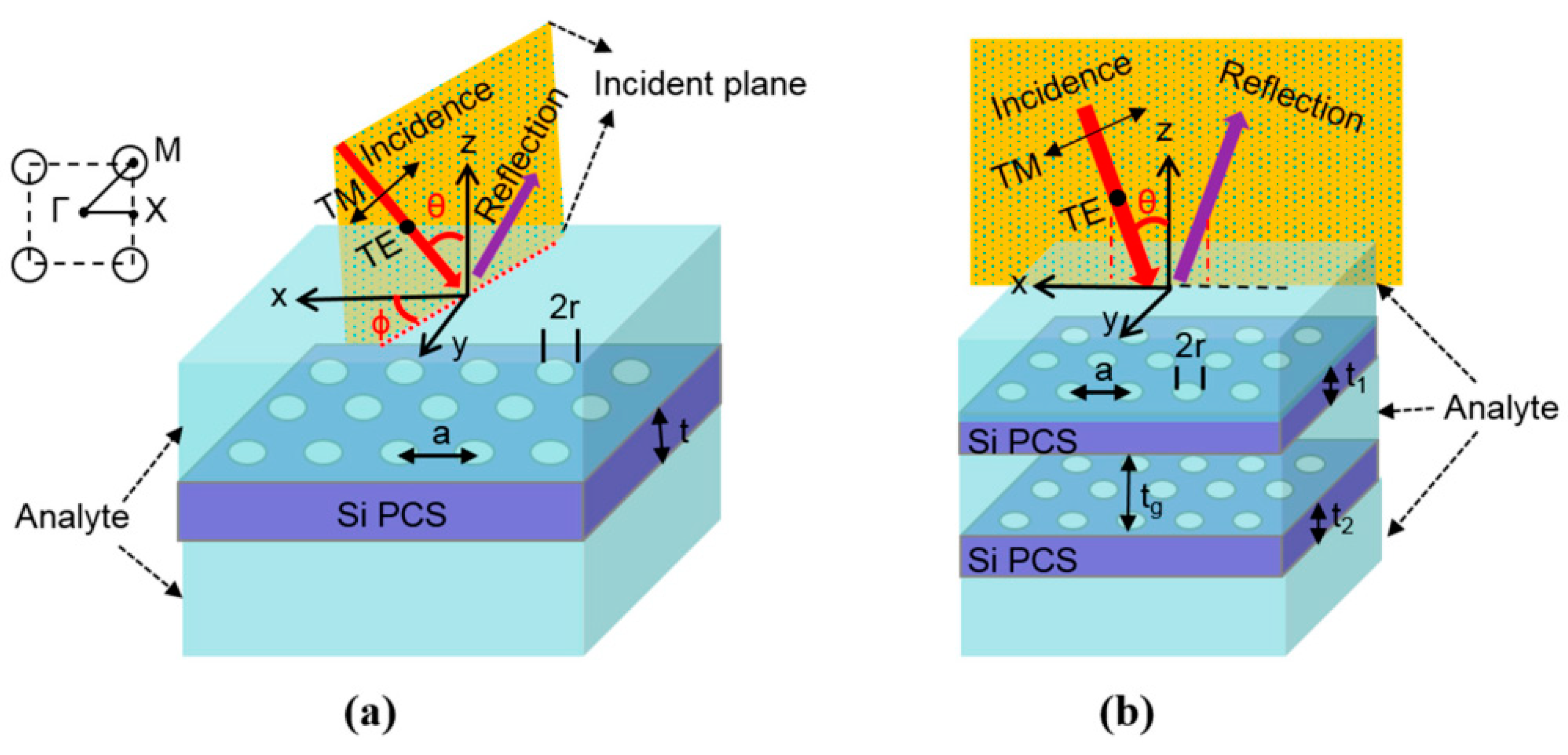


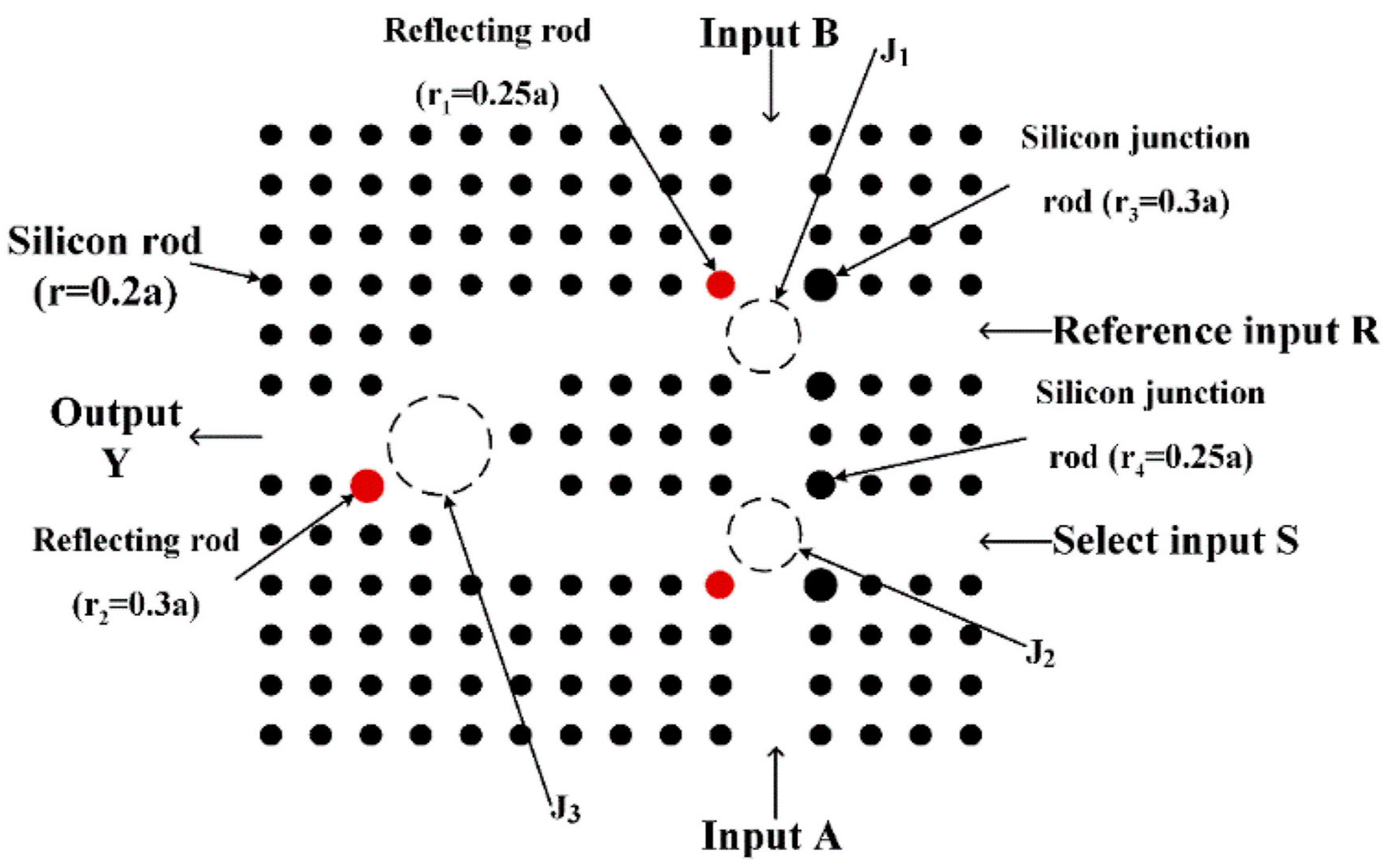
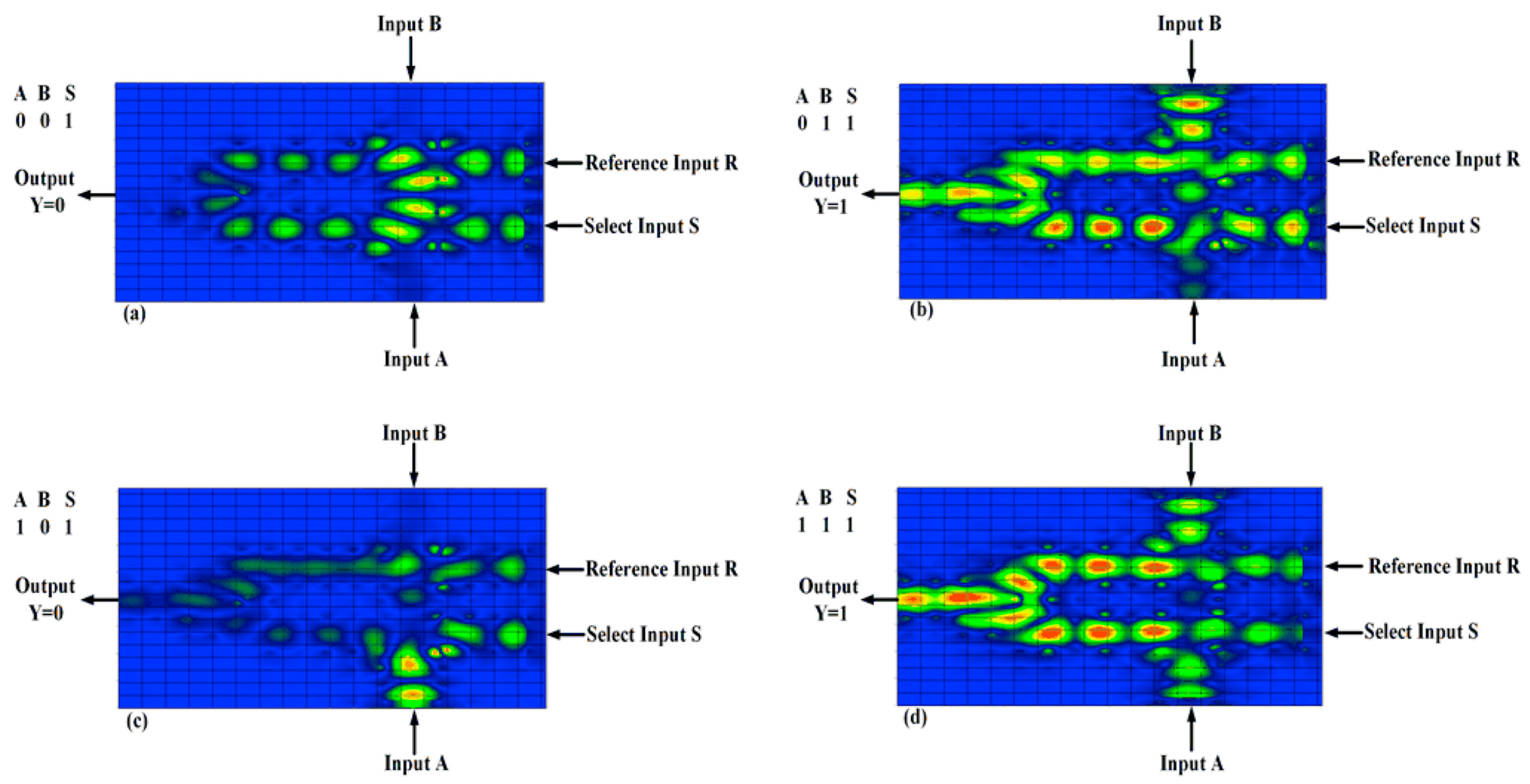
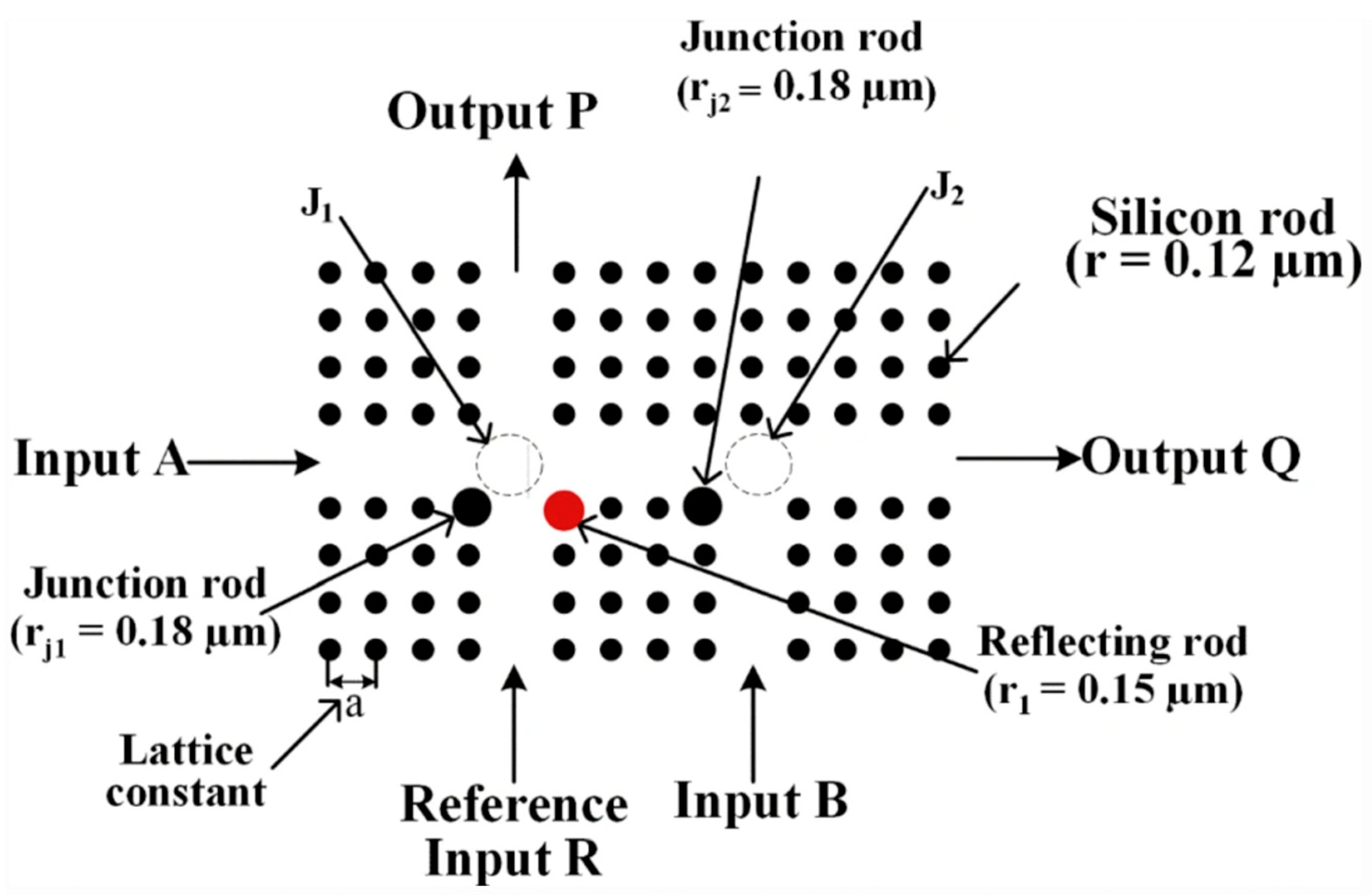


| Photonic Nanostructure | Material | Photocurrent Density | Power Conversion Efficiency | Reference |
|---|---|---|---|---|
| Microcavity | Fe2O3 | 0.35 at 1.23 VRHE | - | [75] |
| Cu2O/ZnO | 0.51 | [76] | ||
| TiO2 | - | [77] | ||
| Polymer solar cells | 4.5 | [78] | ||
| Semitransparent polymer | - | 24–27% | [79] | |
| WO3/Ag/WO3 | - | 8.37% | [80] | |
| PhC | TiO2/ZrO2 | - | - | [81] |
| BiVO4 | 1.35 at 1.2 V vs. Ag/AgCl | - | [82] | |
| Mo:BiVO4 | 2 at 1.0 V vs. Ag/AgCl | - | [83] | |
| Bi2WO6 | - | - | [84] | |
| WO3 | 2.5 at 1.0 V vs. SCE | - | [85] | |
| TiO2 nanodisk | - | 18.7%. | [86] | |
| Silicon | - | 31% | [87] | |
| CdS/TiO2 | 4.84 at 0 V vs. Ag/AgC | - | [88] | |
| PhC + Plasmon | Au/TiO2 | - | - | [89] |
| Au/TiO2 | - | - | [90] | |
| Au/BiVO4 | 3.1 at 1.23 VRHE | - | [91] | |
| TiO2/Au | - | 4.67 | [92] |
| Type of PhC | Sensing Material | Target | Detection Range | Sensitivity | Reference |
|---|---|---|---|---|---|
| Gas Sensors | |||||
| D shape fiber | Ag/Porous TiO2 | Isopropanol | 20–100% | 1.35 nm/% | [118] |
| PhC long-period grating | - | Methane | 0–3.5% | 6.39 nm/% | [119] |
| Microtube PhC | - | Propene | 33 vol% | 8.6–10.1% | [120] |
| hybrid porous core PCF | - | Methane | - | 21.2% | [121] |
| PC slab (PCS) | - | Carbon di oxide | 0–2130 ppm | - | [122] |
| 2D defect PCS | Polymer | Hexane and ethanol | 0–3 ppm | 123.4 nm/RIU | [123] |
| PhC cavity | - | Tetrahydrofuran | 0–31.5 mmol.L−1 | 0.128 nm·mmol.L−1 | [124] |
| PCF | NA | Sulfur Dioxide | 1.3406–1.3388 | 83.64% | [125] |
| PCF | - | Nitrous Oxide and Benzene | 1.295–1.3 | 73.822% 76.422% | [126] |
| Periodic PCS | Graphene | gas | - | - | [127] |
| 2D PhC | - | Sulfuric Acid and Hydrogen Peroxide | 0–90% | 575–600 nm/RIU | [128] |
| Physical sensor | |||||
| Bragg grating PhC | - | Temperature sensor | 5 °C–160 °C | 0.082 nm/°C | [129] |
| Dual-core PhC fiber | Fe3O4 | Magnetic field sensor | 89.9–271 Oe | 305.8 pm/Oe | [130] |
| Elliptical hole PhC Fiber | Platinum | Temperature sensor | 20–160 °C | 77 nm/°C | [131] |
| MMF-PCF | - | Strain sensor | 0–1600 με | ~−14.89 pm/με | [132] |
| D shaped PCF | Au film | Magnetic field and temperature sensor | 5 °C−65 °C 30 Oe~270 Oe | −1.25 nm/°C 0.21 nm/Oe | [133] |
| PhC | Self-adhesive hydrogel | Underwater motion detection | 0–200% | ≈2.09 nm/% | [134] |
| 2D PhC | GaAs | Pressure sensor | 0–5 GPa | 17.00 nm/GPa | [135] |
| PhC micro ring resonator | - | Pressure sensor | 0–0.5 GPa | 25.26 nm/GPa | [136] |
| 2D PhC | - | Pressure Sensor | 0–6 GPa | 3.1 nm/GPa | [137] |
| PCF | Silver | Temperature sensor | 15–35 °C | 2 nm/°C | [138] |
| Refractive index sensor | |||||
| D-shaped PhC Fiber | Gold film | Refractive index | 1.43–1.46 | 7700 nm/RIU | [139] |
| Dual drilled channel | Gold nanowire | Refractive index | 1.31–1.40 | 90,500 nm/RIU | [140] |
| H shaped fiber | Gold nanowire | Refractive index | 1.33–1.40 | 4000 nm/RIU | [141] |
| Tapered PCF | - | Bio-chemical | 1.30–1.32 | 722.3 nm/RIU | [142] |
| Hollow core | Cu nanowire | Refractive index | 1.33–1.38 | 12,400 nm/RIU | [143] |
| Hollow core PCF | - | Poisonous chemical | - | 92.08% | [144] |
| 2D PhC | - | Refractive index | 1.33–1.481 | 347.99–473.38 nm/RIU | [145] |
| Single channel PCF | - | Petrol adulteration | 1.415–1.440 | 20,161.2 nm/RIU | [146] |
| 1D defect PhC | Superconducting material | Biosensing | 0–50% | 68.18–85.22 nm/RIU | [147] |
| 1D PhC | - | Hemoglobin | 10–150 g/L | 1916.77 nm/RIU | [148] |
| 2D PCF | Au film | Protein | 0–10 μg/L | 10−3 μg/mL | [149] |
Disclaimer/Publisher’s Note: The statements, opinions and data contained in all publications are solely those of the individual author(s) and contributor(s) and not of MDPI and/or the editor(s). MDPI and/or the editor(s) disclaim responsibility for any injury to people or property resulting from any ideas, methods, instructions or products referred to in the content. |
© 2023 by the authors. Licensee MDPI, Basel, Switzerland. This article is an open access article distributed under the terms and conditions of the Creative Commons Attribution (CC BY) license (https://creativecommons.org/licenses/by/4.0/).
Share and Cite
Gangwar, R.K.; Pathak, A.K.; Kumar, S. Recent Progress in Photonic Crystal Devices and Their Applications: A Review. Photonics 2023, 10, 1199. https://doi.org/10.3390/photonics10111199
Gangwar RK, Pathak AK, Kumar S. Recent Progress in Photonic Crystal Devices and Their Applications: A Review. Photonics. 2023; 10(11):1199. https://doi.org/10.3390/photonics10111199
Chicago/Turabian StyleGangwar, Rahul Kumar, Akhilesh Kumar Pathak, and Santosh Kumar. 2023. "Recent Progress in Photonic Crystal Devices and Their Applications: A Review" Photonics 10, no. 11: 1199. https://doi.org/10.3390/photonics10111199
APA StyleGangwar, R. K., Pathak, A. K., & Kumar, S. (2023). Recent Progress in Photonic Crystal Devices and Their Applications: A Review. Photonics, 10(11), 1199. https://doi.org/10.3390/photonics10111199







